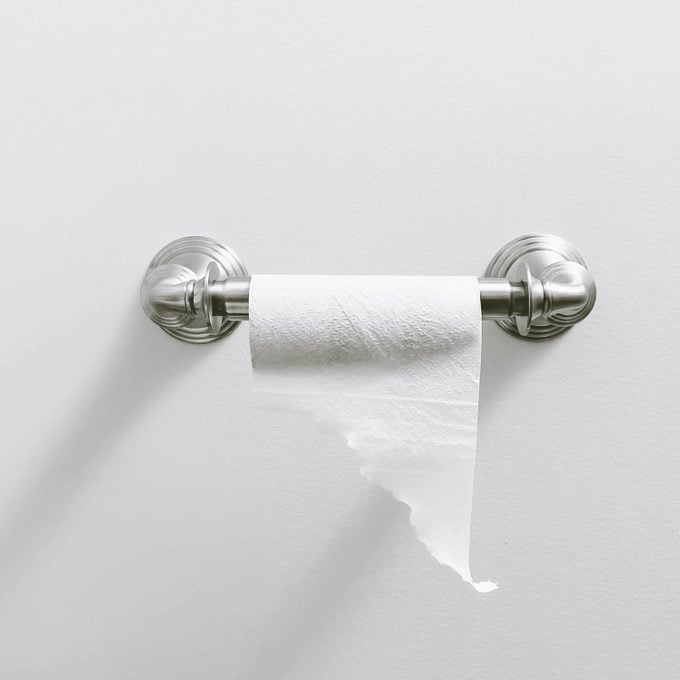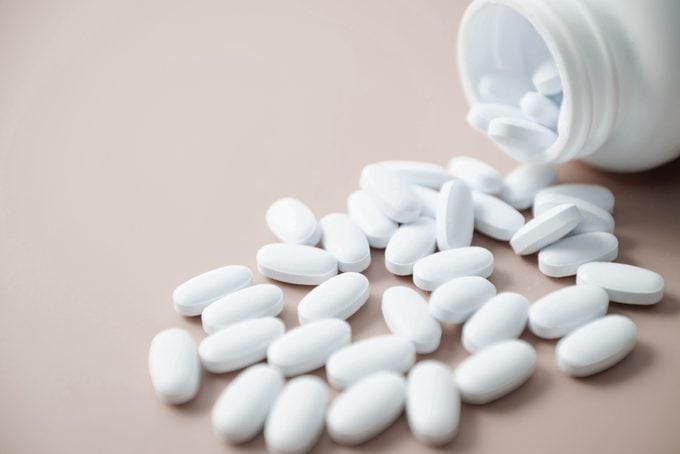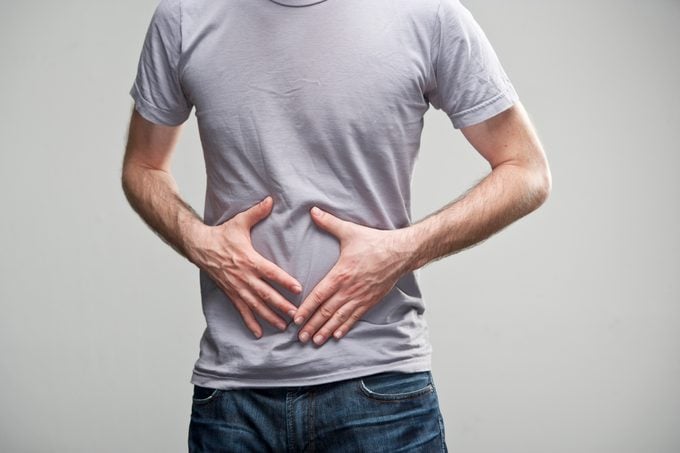Why Is My Poop Light Tan? Here’s What Causes Pale or Clay-Colored Stool
Updated: Mar. 17, 2022
If you have pale or clay-colored stool, it could be something you ate or a medication you are taking. Here are some of the most common causes of light-colored stool—some of them harmless and others that may require medical attention.

If your skin is looking a bit pale (which can occur in people of any skin tone), there’s usually a reason. It could be anything from a vitamin B12 deficiency to a symptom of anemia. The same is true when your stool is a paler-than-normal color—it doesn’t usually happen randomly.
“There’s always going to be a reason,” says Christine Traxler, MD, a family practitioner at Invigor Medical, in Le Sueur, Minnesota, “but it doesn’t necessarily mean you’re dealing with a serious issue.”
What’s a normal poop color?
Generally speaking, poop is brown because as the food you’ve eaten makes its way down your gastrointestinal (GI) tract, it gets stained by bile, explains Harry Thomas, MD, a gastroenterologist in Austin, Texas.
Bile is made in the liver, stored in the gallbladder, and released via the bile duct relatively early on in the digestive process (after food moves from the stomach to the intestine). Bile helps break down fats in the food we eat. That means that your stool starts out a more bilious greenish-yellow but becomes increasingly brown before it finally exits the body. (Is your stool a funny color? Here’s why your poop is green.)
Bile has an important role in giving stool its brown color so when a patient tells Kumar Desai, MD, gastroenterologist, hepatologist, and pancreaticobiliary specialist in Thousand Oaks, California, that their stool appears pale—or the color of wet clay—his first thoughts are about bile and biliary function. Specifically, the issue is whether there isn’t enough bile being produced, or whether bile is, for some reason, being prevented from reaching the stool.
As you might imagine, these can be due to a variety of health issues. (Here are the signs your gut bacteria are unhealthy.)
A word about pale or clay-colored stool
That being said, if you notice pale or clay-colored stool, that doesn’t necessarily mean you have a serious health problem. Although pale stool is not normal, there are a number of reasons why this happens, says family practitioner Kavita Shanker-Patel, MD, practicing family medicine at Northwestern Medicine Central DuPage Hospital, Winfield, Illinois.
While some are serious, others are quite benign. In fact, pale-colored stool can be the result of something you’ve eaten or a medication you are taking.
“Many things can change the color of stool, including food, medication, vitamins as well as certain illnesses,” says colorectal surgeon, Lynn O’Connor, MD, director of colon and rectal surgery of New York and section chief of colon and rectal surgery at Mercy Medical Center and St. Joseph Hospital in New York. (These are the vitamin mistakes you don’t realize you’re making.)
If pale or clay-colored stool (or acholic stool as your doctor might refer to it) is the result of a serious health issue, there are usually other symptoms. Here are some of the reasons you might have pale or clay-colored poop. (Find out the 9 most common reasons why your poop is black.)

You take calcium supplements or calcium-supplemented antacids
As noted by Dr. O’Connor, certain drugs and supplements can cause the stool to appear pale or clay-like. Family care physician, Susan Besser, MD, has seen pale or clay-colored stools in people who habitually take calcium supplements and calcium-supplemented antacids. In fact, calcium-containing antacids are known to cause changes in stool color.
So if you notice pale or clay-colored stool for the first time, ask yourself if you might have inadvertently taken a calcium supplement in the form of an antacid tablet. In the absence of other symptoms, it’s OK to take a wait and see approach.
You have a parasitic infection
The parasitic infection, Giardia lamblia, can turn the stool yellow—anywhere from bright yellow to pale yellow, Dr. O’Connor explains. Symptoms of Giardia can include stomach pain, vomiting, and fever, so if you’re experiencing these symptoms along with pale stool that is yellow-tinged, it would be a good idea to check in with your doctor. Giardia is easily tested for and easily treated. “Most people feel better in a few days after taking medication prescribed by their doctor,” says Dr. O’Connor.
You took a barium test
Barium tests are used to examine the digestive tract using a white powder called barium sulfate that is dissolved in water and introduced into the GI tract via enema or by mouth, Dr. Shanker-Patel explains. Barium isn’t absorbed at all by the body, and what many people don’t realize is how common it is to pass pale, chalky, and/or clay-like stool for several days after swallowing barium. “It’s harmless,” Dr. Traxler agrees.
You eat fatty foods
The fattier the food, the more likely it is to produce pale or clay-colored stool. That’s why the first time you notice pale or clay-colored, in the absence of any other symptoms, it’s usually safe to wait and see if the next one returns to normal before calling a doctor. (Don’t miss these 12 tips for choosing the best primary care physician.)
If you eat a lot of fatty food it can overwhelm the normal digestive process because you are delivering way more fat than your body is used to breaking down with bile. The result is called steatorrhea, which is bulky, smelly, and pale-colored stool that often floats in the toilet instead of sinking to the bottom due to its fatty or oily content.
If steatorrhea is a one-time thing after a particularly fatty meal, it’s not usually a cause for concern. However, if it’s a recurring issue you could have a problem with fat malabsorption, meaning your small intestine is not absorbing fat the way it’s supposed to.
You could have celiac disease
One of the less-known symptoms of celiac disease (an autoimmune condition in which the gluten proteins in wheat and other grains trigger an intestine-damaging immune response), is pale stool, particularly if it’s foul-smelling. Other celiac symptoms include pain, bloating, diarrhea, fatigue, joint pain, and other health problems, like infertility, malnutrition, and osteoporosis.

It could be bile-related
When your stool is pale, and it’s not because of something you ingested, it can mean that your body is not producing enough bile, or that the bile is, for some reason, not reaching your stool. Either way, your stool will lack the pigmentation that makes it appear brown by the time it exits your body.
One of the three organs that make up the biliary system may be the culprit, according to Dr. Traxler. These are the liver, the gallbladder, and the pancreas.
Issues with the liver
One of the liver’s jobs is to produce bile. When it is not producing bile, or not producing enough, pale stools can be one of the symptoms.
Reasons, why the liver might have issues producing adequate bile, include:
- Liver damage from certain medications such as acetaminophen: High doses or regular, long-term use of acetaminophen can cause liver damage, especially if combined with alcohol.
- Cirrhosis: Cirrhosis of the liver, which is most often caused by chronic, excessive alcohol use, causes scar tissue to replace normal tissue in the liver.
- Fatty liver disease: Fatty liver disease (FLD) is essentially an inflammation of the liver. Although it can be caused by alcohol abuse, it is more often caused by obesity. (Here are 9 risk factors for non-alcohol-related FLD.)
- Liver infections: These include the various forms of hepatitis, which are liver-infecting viruses.
- Autoimmune disease of the liver, including autoimmune hepatitis
- Liver cancer: Malignant tumors of the liver are rare, but serious, and can be brought about or hastened by some of the other liver conditions noted here.
- Genetic liver disease: A genetic disorder, known as alagille syndrome, which presents by the age of two, can affect the liver, the heart, and other parts of the body.
The symptoms of any of these liver problems may include:
- nausea and vomiting
- dark urine
- swelling in the ankles or legs
- persistent itching
- pain in the abdomen and back
- swelling of the belly
- weight loss
- jaundice (a yellowing of the skin and or the white parts of the eyes, which is the result of elevated bilirubin levels in the body, which is consistent with biliary malfunction).
Issues with the gallbladder
The gallbladder stores bile the liver has made, and the bile ducts leading out of the gallbladder are responsible for releasing bile into the GI tract to support digestion. If the gallbladder is malfunctioning, the result may be pale stools. The reasons for gallbladder malfunction include:
Gallbladder stones (aka gallstones): A gallstone is a small pebble-like mixture of bile, cholesterol, and calcium. Gallstones can block bile ducts or otherwise hinder gallbladder function. The symptoms of gallstones include nausea, vomiting, and right upper quadrant pain, according to Dr. Traxler.
Cholangitis (aka gallbladder infection or inflammation of the gallbladder): Cholangitis is a bacterial infection within the biliary system that is often associated with gallstones or other bile duct obstruction, according to Dr. Shanker-Patel. Symptoms include those of gallstones, as well as pain radiating all the way to the right shoulder and the right side of the upper back.
Gallbladder Cancer: It’s uncommon, but it can happen and can affect the color of stool. Gallbladder cancer doesn’t always start with gallstones, although it can; here are 7 other symptoms of gallbladder cancer.
A condition called sclerosing cholangitis is a serious condition causing inflammation of the bile ducts affecting the gallbladder and liver. Other conditions like biliary strictures (narrowing of the bile ducts), bile duct cysts, and congenital structural defects all can block the flow of bile.
Issues with the pancreas
“If the pancreas isn’t working, is infected or inflamed, the overall absorption of nutrients will be poor,” explains Dr. Traxler. Pale stools that are visibly fatty and/or unusually foul-smelling could (but does not necessarily) indicate fats aren’t being absorbed properly as a result of pancreatic malfunction.
Pancreatitis, which can be caused by gallstones or a pancreatic tumor, and pancreatic cancer (a malignant pancreatic tumor) are two possible causes for pancreatic malfunction.
When to see a doctor
As we said, if you’ve had a single bowel movement with pale or clay-colored stool, it is probably safe to wait and see if the next bowel movement appears normal. However, the following co-occurring symptoms require urgent attention. If you experience any of these, it is a sign you need to get immediate medical attention and see a doctor:
- Fever—which could indicate acute infection/inflammation.
- Abdominal pain—which can also indicate acute infection/inflammation.
- Jaundice—it’s never a good idea to ignore a problem that’s causing your skin or the whites of your eyes to turn yellow.
- Unintended weight loss/lack of appetite—this could indicate serious illness when coupled with pale stools and warrants medical attention.
- Severe diarrhea with signs of dehydration. Diarrhea can cause dehydration, which can quickly become life-threatening in some patients.
























